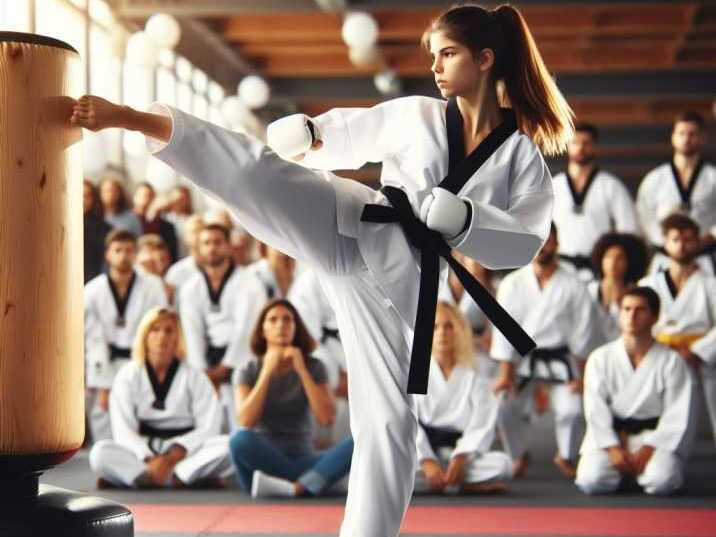Introduction:
Table of Contents
Boxing vs Taekwondo
In the realm of combat sports, two disciplines stand out for their distinct styles and techniques: boxing and Taekwondo. While both sports involve intense physical exertion and strategic prowess, they differ significantly in their approach to combat. In this comprehensive analysis, we delve into the nuances of boxing vs Taekwondo, examining their techniques, strategies, origins, and more.
Boxing: The Sweet Science
Origins and History:
Boxing, also known as the “sweet science,” has a rich history dating back thousands of years. Originating in ancient Greece as a form of entertainment and ritual, boxing evolved over the centuries into a structured sport with rules and regulations. In the modern era, boxing gained widespread popularity in the 18th and 19th centuries, becoming a staple of both amateur and professional sports.
Techniques and Training:
Boxing is characterized by its focus on punching techniques, primarily using the fists for offense and defense. Fighters are trained in various types of punches, including jabs, hooks, crosses, and uppercuts, each executed with precision and speed. Footwork plays a crucial role in boxing, with fighters constantly moving to maintain distance and create angles for attack.

Strategies and Tactics:
In boxing, strategy revolves around exploiting openings in the opponent’s defense while minimizing exposure to counterattacks. Fighters employ a combination of feints, footwork, and defensive maneuvers to outsmart their opponents and land decisive blows. Defense is equally important in boxing, with fighters utilizing techniques such as slipping, blocking, and parrying to evade punches and minimize damage.
Taekwondo: The Art of Kicking
Origins and History:
Taekwondo, which translates to “the way of the foot and fist,” originated in Korea and has ancient roots in traditional martial arts such as Taekkyon and Subak. Developed as a form of self-defense and physical fitness, Taekwondo evolved into a codified martial art with standardized techniques and forms. It gained international recognition in the 20th century and became an official Olympic sport in 2000.
Techniques and Training:
Taekwondo is characterized by its emphasis on kicking techniques, with practitioners utilizing a wide range of kicks, including front kicks, roundhouse kicks, side kicks, and spinning kicks. Hand techniques are also taught in Taekwondo, albeit to a lesser extent than in boxing. Training in Taekwondo focuses on developing flexibility, agility, and explosive power to execute swift and powerful kicks.

Strategies and Tactics:
In Taekwondo, strategy revolves around using kicks to maintain distance, control the pace of the fight, and score points. Fighters aim to execute kicks with precision and speed, targeting specific areas of the opponent’s body for maximum impact. Footwork is crucial in Taekwondo, with fighters constantly shifting stances and adjusting their positioning to set up kicks and evade attacks.
Comparison: Boxing vs Taekwondo
Now that we’ve explored the fundamentals of boxing vs Taekwondo, let’s compare the two disciplines across various aspects:
- Techniques:
- Boxing focuses primarily on punching techniques, with an emphasis on using the fists for offense and defense.
- Taekwondo emphasizes kicking techniques, with practitioners utilizing a wide range of kicks to target different areas of the opponent’s body.
- Training:
- Boxing training emphasizes footwork, punching drills, and defensive maneuvers such as slipping and blocking.
- Taekwondo training focuses on developing flexibility, agility, and explosive power to execute kicks with precision and speed.
- Strategies:
- In boxing, fighters aim to exploit openings in the opponent’s defense using a combination of feints, footwork, and defensive maneuvers.
- In Taekwondo, fighters use kicks to maintain distance, control the pace of the fight, and score points while constantly shifting stances and adjusting positioning.
- Defense:
- Boxing defense includes techniques such as slipping, blocking, and parrying to evade punches and minimize damage.
- Taekwondo defense involves using footwork and blocking techniques to evade kicks and counter effectively.
- Competitive Formats:
- Boxing competitions are typically conducted in a ring, with fighters aiming to win by knockout, technical knockout, or decision.
- Taekwondo competitions take place on a matted area, with points awarded for clean kicks and punches to specific areas of the body.
Conclusion:
In conclusion, boxing vs Taekwondo are both formidable combat sports with unique styles, techniques, and strategies. While boxing emphasizes punching techniques and defensive maneuvers, Taekwondo focuses on kicking techniques and agility. Whether you prefer the precision and power of boxing or the agility and flexibility of Taekwondo, both disciplines offer a rewarding experience for practitioners and spectators alike.
FAQs (Frequently Asked Questions):
- Which sport is better for self-defense, boxing, or Taekwondo?
- Both boxing and Taekwondo can be effective for self-defense, depending on the situation and individual skill level.
- Is Taekwondo more suitable for children than boxing?
- Taekwondo is often recommended for children due to its emphasis on discipline, respect, and physical fitness.
- Do boxers and Taekwondo practitioners spar during training?
- Yes, both boxers and Taekwondo practitioners engage in sparring sessions to practice their techniques in a simulated combat environment.
- Which sport has a higher risk of injury, boxing, or Taekwondo?
- Both sports carry a risk of injury, but the type and frequency of injuries may vary depending on factors such as training intensity and protective gear.
- Can someone cross-train in both boxing and Taekwondo?
- Yes, many athletes choose to cross-train in multiple martial arts disciplines to improve their overall skills and versatility.


